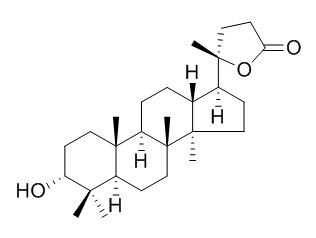Cabraleahydroxylactone
Cabraleahydroxylactone displays antimycobacterial activity against Mycobacterium tuberculosis, it is weakly cytotoxic to a breast cancer (BC) cell line.It shows antiviral activity against herpes simplex virus type-1 with an IC50 value of 3.20 ug/mL, in comparison with the standard acyclovir (IC50=1.90ug/mL).
Inquire / Order:
manager@chemfaces.com
Technical Inquiries:
service@chemfaces.com
Tel:
+86-27-84237783
Fax:
+86-27-84254680
Address:
1 Building, No. 83, CheCheng Rd., Wuhan Economic and Technological Development Zone, Wuhan, Hubei 430056, PRC
Providing storage is as stated on the product vial and the vial is kept tightly sealed, the product can be stored for up to
24 months(2-8C).
Wherever possible, you should prepare and use solutions on the same day. However, if you need to make up stock solutions in advance, we recommend that you store the solution as aliquots in tightly sealed vials at -20C. Generally, these will be useable for up to two weeks. Before use, and prior to opening the vial we recommend that you allow your product to equilibrate to room temperature for at least 1 hour.
Need more advice on solubility, usage and handling? Please email to: service@chemfaces.com
The packaging of the product may have turned upside down during transportation, resulting in the natural compounds adhering to the neck or cap of the vial. take the vial out of its packaging and gently shake to let the compounds fall to the bottom of the vial. for liquid products, centrifuge at 200-500 RPM to gather the liquid at the bottom of the vial. try to avoid loss or contamination during handling.
FARMACIA2023, Vol.71,3.
The Japan Society for Analytical Chemistry2017, 613-617
Chung Shan Medical University2020, US20200323790A1
Biotechnology and Bioprocess Engineering2024, 29:1048-1060.
J Ginseng Res.2023, 47(4):572-582.
Journal of Functional Foods2021, 84:104581
Chinese J of Tissue Engineering Res.2022, 26(17): 2636-2641.
J Ginseng Res.2022, 46(1):104-114.
J Cell Biochem.2022, 123(7):1222-1236.
Phytomedicine.2019, 57:95-104
Related and Featured Products
Arch Pharm Res. 2008 Jan;31(1):21-7.
A new sesquiterpene and other terpenoid constituents of Chisocheton penduliflorus.[Pubmed:
18277603]
METHODS AND RESULTS:
A new aromadendrane sesquiterpene, allo-aromadendrane-10alpha, 14-diol (3), was isolated from Chisocheton penduliflorus (Meliaceae), along with two known sesquiterpenes: allo-aromadendrane-10beta, 14-diol (2) and allo-aromadendrane-10beta, 13, 14-triol (7). Six dammarane triterpenoids, including cabraleadiol (1), eichlerialactone (4), Cabraleahydroxylactone (5), cabralealactone (6), hollongdione (8) and dammaradienone (9), the coumarins scoparone and scopoletin, and vanillic acid were also isolated from the wood and leaves of this plant. Compounds 1-7 displayed antimycobacterial activity against Mycobacterium tuberculosis.
CONCLUSIONS:
Compounds 1, 4, 5 and 6 were weakly cytotoxic to a breast cancer (BC) cell line; whereas, compound 6 was moderately active against a small-cell lung cancer (NCI-H187) cell line.
Nat Prod Res. 2011 Oct;25(17):1621-8.
Biologically active constituents of Aglaia erythrosperma.[Pubmed:
22011221]
METHODS AND RESULTS:
From the fruits and leaves of Aglaia erythrosperma (Meliaceae), 10 chemical constituents were isolated and identified, i.e. the dammarane triterpenoids cabraleadiol (1), Cabraleahydroxylactone (2), ethyl eichlerianoate (3), eichlerialactone (4), aglinin A (5), cabralealactone (6), the aglaialactone 5,6-desmethylenedioxy-5-methoxy-aglalactone (7), the flavagline 4'-demethoxy-3',4'-methylenedioxy-methyl rocaglate (8) and two coumarins: scoparone and scopoletin. Flavagline 8 exhibited antimalarial activity with an IC(50) value of 7.30 μg mL(-1) and was strongly cytotoxic against small cell lung cancer (NCI-H187), epidermoid carcinoma (KB) and breast cancer (BC) cell lines, with IC(50) values of 2.17, 2.10 and 0.11 μg mL(-1), respectively.
CONCLUSIONS:
Aglinin A (5) displayed moderate cytotoxicity against all the three cancer cell lines, whereas ethyl eichlerianoate (3), cabralealactone (6) and the aglaialactone 7 were exclusively cytotoxic to NCI-H187 cell line. Cabraleahydroxylactone (2) showed antiviral activity against herpes simplex virus type-1 with an IC(50) value of 3.20 μg mL(-1), in comparison with the standard acyclovir (IC(50) = 1.90 μg mL(-1)). When tested for antimycobacterial activity against Mycobacterium tuberculosis H(37)Ra, compounds 1-4 and 6-8 displayed minimum inhibitory concentration in the range of 25-50 μg mL(-1).
Bioorg Med Chem. 2006 Feb 15;14(4):960-72.
Activity-guided isolation of cytotoxic constituents from the bark of Aglaia crassinervia collected in Indonesia.[Pubmed:
16216518]
METHODS AND RESULTS:
Activity-guided fractionation of a CHCl(3)-soluble partition of the MeOH extract of the bark of Aglaia crassinervia collected in Indonesia led to the isolation of three new glabretal-type triterpenoids, aglaiaglabretols A-C (1-3), as well as nine known compounds, 3-epi-Cabraleahydroxylactone (4), Cabraleahydroxylactone (5), rocaglaol (6), 2beta,3beta-dihydroxy-5alpha-pregn-17(20)-(E)-16-one, scopoletin, and mixtures of cabraleadiol and epicotillol and of beta-sitosterol and stigmasterol. The structures of compounds 1-3 were determined on the basis of spectroscopic and chemical methods. The structure of aglaiaglabretol A (1) was confirmed by single-crystal X-ray analysis, and the absolute stereochemistry of this isolate was established by the Mosher ester method. The cytotoxic activity of all isolates and several chemical transformation products obtained in the present study was evaluated.
CONCLUSIONS:
The known cyclopenta[b]benzofuran, rocaglaol (6), was found to be significantly active and comparable in potency to the positive controls, paclitaxel and camptothecin. Aglaiaglabretol B (2) was further tested in an in vivo hollow fiber model.



